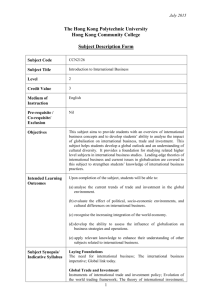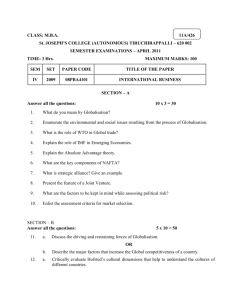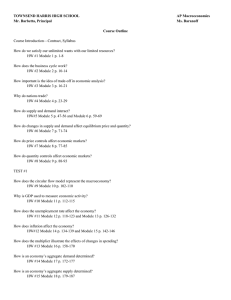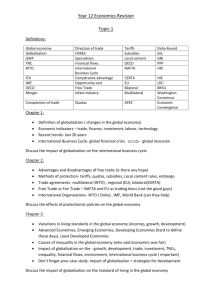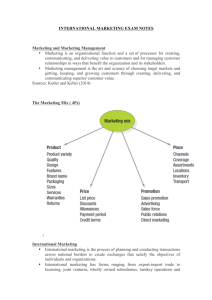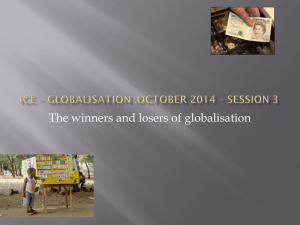The Global Economy
advertisement
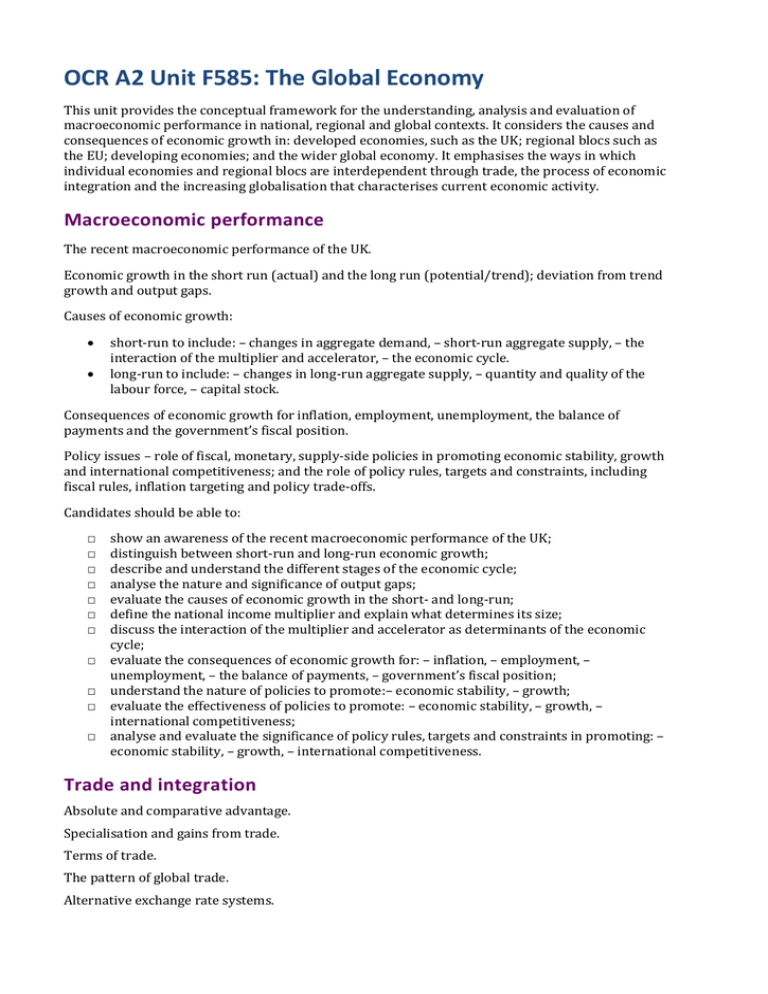
OCR A2 Unit F585: The Global Economy This unit provides the conceptual framework for the understanding, analysis and evaluation of macroeconomic performance in national, regional and global contexts. It considers the causes and consequences of economic growth in: developed economies, such as the UK; regional blocs such as the EU; developing economies; and the wider global economy. It emphasises the ways in which individual economies and regional blocs are interdependent through trade, the process of economic integration and the increasing globalisation that characterises current economic activity. Macroeconomic performance The recent macroeconomic performance of the UK. Economic growth in the short run (actual) and the long run (potential/trend); deviation from trend growth and output gaps. Causes of economic growth: short-run to include: – changes in aggregate demand, – short-run aggregate supply, – the interaction of the multiplier and accelerator, – the economic cycle. long-run to include: – changes in long-run aggregate supply, – quantity and quality of the labour force, – capital stock. Consequences of economic growth for inflation, employment, unemployment, the balance of payments and the government’s fiscal position. Policy issues – role of fiscal, monetary, supply-side policies in promoting economic stability, growth and international competitiveness; and the role of policy rules, targets and constraints, including fiscal rules, inflation targeting and policy trade-offs. Candidates should be able to: □ □ □ □ □ □ □ □ □ □ □ show an awareness of the recent macroeconomic performance of the UK; distinguish between short-run and long-run economic growth; describe and understand the different stages of the economic cycle; analyse the nature and significance of output gaps; evaluate the causes of economic growth in the short- and long-run; define the national income multiplier and explain what determines its size; discuss the interaction of the multiplier and accelerator as determinants of the economic cycle; evaluate the consequences of economic growth for: – inflation, – employment, – unemployment, – the balance of payments, – government’s fiscal position; understand the nature of policies to promote:– economic stability, – growth; evaluate the effectiveness of policies to promote: – economic stability, – growth, – international competitiveness; analyse and evaluate the significance of policy rules, targets and constraints in promoting: – economic stability, – growth, – international competitiveness. Trade and integration Absolute and comparative advantage. Specialisation and gains from trade. Terms of trade. The pattern of global trade. Alternative exchange rate systems. Purchasing power parity. Exchange rate fluctuations. Causes and consequences of balance of payments problems. Policies to correct imbalances. Stages of economic integration: free-trade areas; customs unions; single markets; economic unions; monetary unions. Impact of economic integration: short-run – trade creation and trade diversion; long-run – dynamic effects. Candidates should be able to: □ □ □ □ □ □ □ □ □ □ □ □ □ □ □ distinguish between absolute and comparative advantage; analyse the effects of international trade; outline the pattern of global trade; evaluate comparative advantage as an explanation of global trade patterns; define, measure and analyse the significance of the terms of trade, and changes in the terms of trade over time; explain how exchange rates are determined in different exchange rate systems; evaluate the relative merits and drawbacks of different exchange rate systems; explain purchasing power parity; evaluate the causes and consequences of exchange rate fluctuations; analyse the causes of imbalances on the balance of payments; evaluate policies to correct imbalances on the balance of payments; evaluate the case for and against protectionism; understand and explain the stages of economic integration; be familiar with different examples of economic integration, such as: – EU (European Union), – NAFTA (North American Free Trade Agreement), – ASEAN (Association of South East Asian Nations); evaluate the internal and external consequences of economic integration. Development and sustainability Meaning and measurement of development: the relationship between growth and development, GDP per capita, HDI (Human Development Index), economies at different stages of development, common and diverse characteristics. Policies to promote economic development; the role of the market and the state, and international trade. The constraints on development: resource endowment, infrastructure, institutions, finance and savings, and international. Candidates should be able to: □ □ □ □ distinguish between growth and development; explain the relationship between growth and development; understand the details and limitations of GDP per capita and HDI (Human Development Index) as measures of development; recognise the common and diverse features of developing economies as they develop; 2 Development and sustainability | □ evaluate the effectiveness of policies to promote development; The economics of globalisation The characteristics and consequences of globalisation. International financial flows (private, official, short-term and long-term flows). Nature and impact of multinational firms. Foreign Direct Investment (FDI). The role and impact of international financial institutions (WTO, IMF and World Bank). International trade negotiations and trade disputes. Candidates should be able to: □ □ □ □ □ □ □ □ understand the different characteristics of globalisation; explain the factors promoting globalisation; evaluate the impact of multinational firms; analyse the influences on the different flows of international finance; evaluate the effects of different flows of international finance; evaluate the impact of globalisation; explain the roles of: – WTO (World Trade Organisation), – IMF (International Monetary Fund), – World Bank; comment upon the issues surrounding current international trade negotiations and trade disputes. Assessment 25% of the total Advanced GCE marks 2h written paper 60 marks. Sat in January Candidates are required to answer questions based upon pre-released stimulus material. Some questions may involve data interpretation. Most questions will require an essay-style answer of varied lengths written in continuous prose. All questions are mandatory. | The economics of globalisation 3

